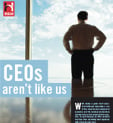 From casual Fridays to corporate retreats, companies spend thousands of hours and millions of dollars to develop passionate, committed employees. Yet, according to a recent Gallup poll, more than 71% of employed adults aren’t engaged at work.
From casual Fridays to corporate retreats, companies spend thousands of hours and millions of dollars to develop passionate, committed employees. Yet, according to a recent Gallup poll, more than 71% of employed adults aren’t engaged at work.
In the following Q&A, Dr. Robert Hogan discusses why companies are getting it wrong, and what they can do to improve engagement.
What is engagement?
Employee engagement is a psychological state that is associated with behaviors beneficial to an organization. The psychological opposite of engagement is alienation.
Engagement has four components:
1. Employees see their job as consistent with their self image – they like themselves when they are at their job;
2. Employees like the job itself;
3. Employees work hard at their job;
4. The job gives employees a sense of meaning and purpose.
Engagement is an ideal state that is rarely ever fully realized.
Why does engagement matter for (a) individuals and (b) companies?
When employees are engaged, they work hard and take pride in their jobs. When they are alienated, they won’t and don’t.
When employees are engaged, absenteeism, turnover, and theft go down, and productivity and customer satisfaction go up. When employees are alienated, absenteeism, turnover, and theft go up, and productivity and customer satisfaction go down.
Measures of engagement are correlated with every important organizational outcome, at both the individual and team level.
A recent Gallup report indicated that 71% of employees in America aren’t engaged at work. How did engagement become such a widespread problem?
Engagement reflects how employees are treated by their immediate bosses. Because 60% to 70% of existing managers don’t understand leadership, they alienate their direct reports and staff.
What is the impact of managers’ derailers on employee engagement?
The term derailer refers to inappropriate interpersonal behavior; managers’ derailers are the principal cause of employee alienation.
Do some derailers have a greater impact on engagement than others?
The 11 derailers identified by the HDS are all associated with different forms of poor leadership, but they all have the effect of destroying employees’ trust in their boss, which then leads to alienation.
How does culture affect engagement?
Cultures that encourage trust in leadership and employee empowerment create engagement; cultures that focus exclusively on the bottom line tend to erode engagement.
What can companies do to drive employee engagement?
There are three steps to driving engagement:
1. Conduct an engagement survey to determine where things are.
2. Identify the managers who are killing engagement and give them some training.
3. Tell the managers who are killing engagement that they will be evaluated in terms of their ability to create engagement.




 When it comes to understanding your employees, it boils down to three basic questions:
When it comes to understanding your employees, it boils down to three basic questions: When it comes to understanding your employees, it boils down to three basic questions:
When it comes to understanding your employees, it boils down to three basic questions: “What is your greatest weakness?”
“What is your greatest weakness?” “What is your greatest weakness?”
“What is your greatest weakness?” From casual Fridays to corporate retreats, companies spend thousands of hours and millions of dollars to develop passionate, committed employees. Yet, according to a recent Gallup poll, more than 71% of employed adults aren’t engaged at work.
From casual Fridays to corporate retreats, companies spend thousands of hours and millions of dollars to develop passionate, committed employees. Yet, according to a recent Gallup poll, more than 71% of employed adults aren’t engaged at work. From casual Fridays to corporate retreats, companies spend thousands of hours and millions of dollars to develop passionate, committed employees. Yet, according to a recent Gallup poll, more than 71% of employed adults aren’t engaged at work.
From casual Fridays to corporate retreats, companies spend thousands of hours and millions of dollars to develop passionate, committed employees. Yet, according to a recent Gallup poll, more than 71% of employed adults aren’t engaged at work. Understanding the dynamics of a team is critical to successful goal attainment. What does the team value? What drives the team members and sets them up for success, and more importantly, what derailment obstacles may they encounter?
Understanding the dynamics of a team is critical to successful goal attainment. What does the team value? What drives the team members and sets them up for success, and more importantly, what derailment obstacles may they encounter?  Understanding the dynamics of a team is critical to successful goal attainment. What does the team value? What drives the team members and sets them up for success, and more importantly, what derailment obstacles may they encounter?
Understanding the dynamics of a team is critical to successful goal attainment. What does the team value? What drives the team members and sets them up for success, and more importantly, what derailment obstacles may they encounter?